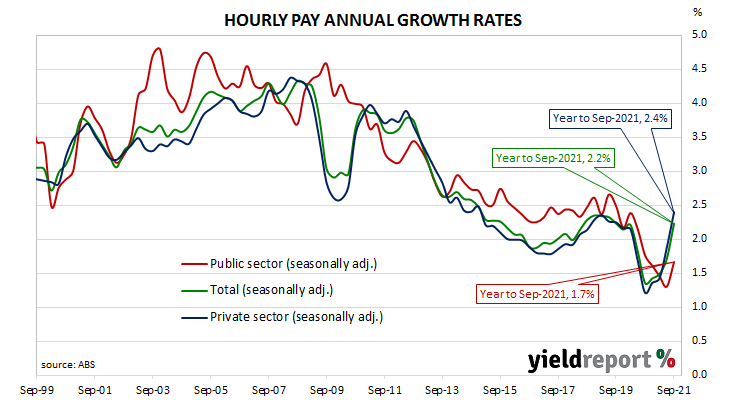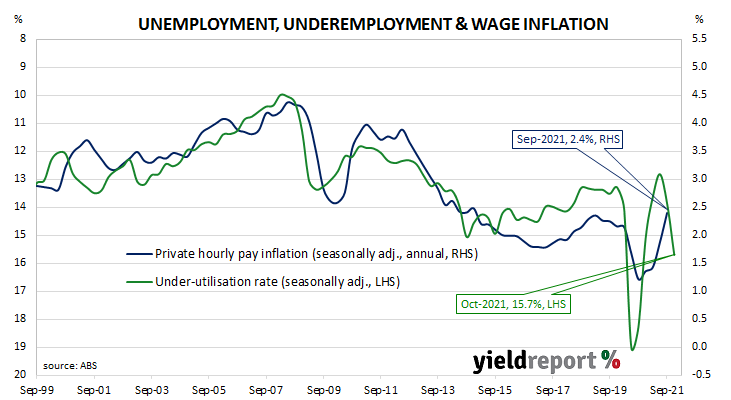Summary: September quarter wages grow by 0.6%, in line with expectations; annual growth rate moves from 1.7% to 2.2%; wages lift where labour shortages “more pronounced”; private sector wages increase by 2.4% over year, public sector up by 1.7%; “some positive signs”; ABS underutilisation rate implies higher wage growth in December quarter; lower wage growth expected in March 2022 quarter unless underutilisation rate declines.
After unemployment increased and wage growth slowed during the GFC, a resources investment boom prompted a temporary recovery back to nearly 4% per annum. However, from mid-2013 through to the September quarter of 2016, the pace of wage increases slowed, until mid-2017 when it began to slowly creep upwards. After remaining fairly stable at around 2.2% per annum from September 2018 to March 2020, the growth rate slowed significantly in the June and September quarters of 2020.
According to the latest Wage Price Index (WPI) figures published by the Australian Bureau of Statistics (ABS), hourly wages grew by 0.6% in the September quarter. The increase in line with expectations but greater than the 0.4% rise in the June quarter. On an annual basis, the growth rate moved up from the June quarter’s rate of 1.7% to 2.2%.
“While wages have indeed lifted in industries where labour shortages are more pronounced, we are yet to see broader wage gains,” said Westpac senior economist Justin Smirk.
Domestic Treasury bond yields moved lower on the day. By the close of business, the 2-year ACGB yield had each shed 5bps to 1.17% and the 10-year yield had slipped 1bp to 1.85%. The 20-year yield finished 5bps higher at 2.41%.
In the cash futures market, expectations of any material change in the actual cash rate, currently at 0.04%, remained fairly soft. At the end of the day, contract prices implied the cash rate would not exceed the RBA’s 0.10% target rate until May 2022 but then rise to 0.95% by December 2022.
ANZ senior economist Catherine Birch noted “some positive signs” in that individually-arranged wage rises were higher than in the September quarters of 2018 and 2019. Additionally, the professional services and construction sectors experienced gains not seen “since the early 2010s”. Birch also pointed to a 1.0% increase over the quarter in the hospitality sector despite a deferral of the minimum award wage rise to the December quarter.
Hourly wage growth in the public sector has been generally faster than in the private sector since late 2013. However, wages in the private sector grew by 0.6% in the September quarter while wages in the public sector grew by 0.5%. Over the past 12 months, wages in the private sector increased by 2.4% while public sector wages grew by 1.7%. Annual wage growth in the two sectors had been at 1.9% and 1.3% respectively in the June quarter after revisions.
The “underutilisation rate” is simply the sum of the unemployment and underemployment rates as per ABS monthly statistics. It has a good correlation with private wage growth one quarter in the future and thus it is useful as a leading indicator. However, differences can open up from time to time. September’s underutilisation rate suggests private wage growth is likely to accelerate in the December quarter but then slow in the March 2022 unless the underutilisation rate reverses October’s rise.
Each quarter the ABS surveys around 3,000 private and public enterprises regarding a sample of jobs in each workplace to measure changes in the price of labour across 18,000 jobs. The results are used to construct the Wage Price Index in a manner similar to the construction of the Consumer Price Index (CPI). Changes in the WPI over time provide a measure of changes in wages and salaries, independently of the type or quantity of work.



